Technology to help farmers’ market managers better understand and serve customers

 Case Western Reserve’s Technology Transfer Office negotiated an option and evaluation agreement for the FM Tracks app with Wholesome Wave, a nonprofit organization dedicated to increasing affordable access of healthy, locally grown fruits and vegetables for underserved consumers. The CWRU-Wholesome Wave partnership brings together researchers and healthy food incentive practitioners to increase affordable access to healthy foods.
With funding from a FINI Grant, Wholesome Wave, based in Bridgeport, Conn., will use FM Tracks to provide a common system for data collection and evaluation at more than 500 farmers' markets across the United States. CWRU is an evaluator of this national project using the FM Tracks system, Freedman said. The goal is to have nationwide rollout of the FM Tracks app and website in early 2016.
“Until now, no technology tool existed in our field that allowed the means to develop industry standards for uniform nutrition incentive data collection,” said Michel Nischan, Wholesome Wave CEO and founder. “FM Tracks does just that.”
Nischan said the technology partnership with Case Western Reserve will help Wholesome Wave advance policy change around nutrition incentives.
FM Tracks, an iOS app and web-based portal, will serve as a critical tool as Wholesome Wave launches a randomized control trial study to measure the impact of nutrition incentive programs on consumers’ purchases and consumption of fruits and vegetables. FM Tracks users can gather data from people receiving benefits from SNAP, which provides nutrition assistance to millions of eligible, low-income individuals and families and provides economic benefits to communities.
Data collected from the use of FM Tracks will be critical to inform future policies impacting the affordability and accessibility of healthy foods, consumer health and economic development for local communities and small and midsized farms, Freedman said.
“What spurred me to develop FM Tracks,” Freedman said, “was the potential to have something available to support implementation of healthy food incentive programs in the places where they are most needed.”
Case Western Reserve’s Technology Transfer Office negotiated an option and evaluation agreement for the FM Tracks app with Wholesome Wave, a nonprofit organization dedicated to increasing affordable access of healthy, locally grown fruits and vegetables for underserved consumers. The CWRU-Wholesome Wave partnership brings together researchers and healthy food incentive practitioners to increase affordable access to healthy foods.
With funding from a FINI Grant, Wholesome Wave, based in Bridgeport, Conn., will use FM Tracks to provide a common system for data collection and evaluation at more than 500 farmers' markets across the United States. CWRU is an evaluator of this national project using the FM Tracks system, Freedman said. The goal is to have nationwide rollout of the FM Tracks app and website in early 2016.
“Until now, no technology tool existed in our field that allowed the means to develop industry standards for uniform nutrition incentive data collection,” said Michel Nischan, Wholesome Wave CEO and founder. “FM Tracks does just that.”
Nischan said the technology partnership with Case Western Reserve will help Wholesome Wave advance policy change around nutrition incentives.
FM Tracks, an iOS app and web-based portal, will serve as a critical tool as Wholesome Wave launches a randomized control trial study to measure the impact of nutrition incentive programs on consumers’ purchases and consumption of fruits and vegetables. FM Tracks users can gather data from people receiving benefits from SNAP, which provides nutrition assistance to millions of eligible, low-income individuals and families and provides economic benefits to communities.
Data collected from the use of FM Tracks will be critical to inform future policies impacting the affordability and accessibility of healthy foods, consumer health and economic development for local communities and small and midsized farms, Freedman said.
“What spurred me to develop FM Tracks,” Freedman said, “was the potential to have something available to support implementation of healthy food incentive programs in the places where they are most needed.”



